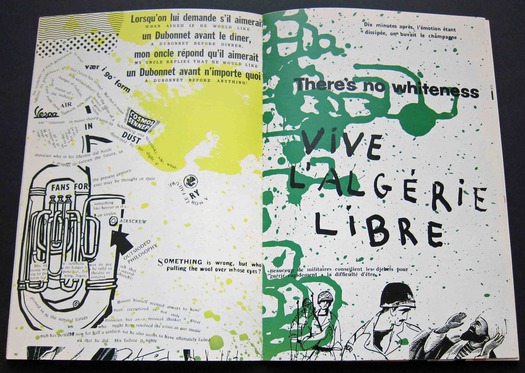

White card wrappers housed in original Viks Grade 2 sandpaper jacket.

"The book speaks secret languages made out of the words and pictures everyone already knows," wrote Greil Marcus "turning a page is like waking from a dream or falling into one." An uncommonly well-kept example of perhaps the quintessential Situationist publication. The violent cutting-out and cutting-up of the textual appropriator mirrors the famous sandpaper cover of the first edition - the printer's own idea - designed to leave its mark on every other book it touches, and on the fingertips of every reader. Jorn's colored ink splotches overlay the borrowed elements, drawing connecting lines between some words and images, nearly obliterating others. A fragmentary collage of snippets and hints and half-lines, photographs and comic strip panels, vigorously detourned and spirited out of their old context into a new one of Debord's own designing. Explore the Book This is a preview only - view fullsize on archive.Rare first edition of the confrontational and abrasive collaboration between two founding members of the Situationist International. Jorn had asked for an unconventional material as a book cover. The book is furnished with a sandpaper cover after a suggestion made by the printer, V. Published in December 1958, it is the second of their two. The last page is an orange swirl, above which reads the single sentence 'I wanted to speak the beautiful language of my century.' Rare first edition of the confrontational and abrasive collaboration between two founding members of. Mmoires Memories is an artists book made by Asger Jorn in collaboration with Guy Debord. Originally deriving from Dada, détournement would become a key situationist strategy. Détournement ('diversion' or 'disruption') is also employed in the book to disorient the reader by creating startling collaged juxtapositions.

Other pages deal with more personal themes, including a cartoon of the first showing of his film Hurlements en Faveur de Sade, with comments for and against, and references to Dérive, which would become known as Situationist Drift, the habit of walking aimlessly through a city in an attempt to find its spirit. The black layer contains fragments of text, maps of Paris and London, illustrations of siege warfare, cheap reproductions of old masters and questions such as 'How do you feel about the world at the moment, Sir?' The coloured layer contains freefloating ink splashes, lines created by a matchstick loaded in ink, and a Rorschach inkblob. These sometimes connect images and text, sometimes cover them, and sometimes are seemingly unconnected. Hvert afsnit med blyantsnummer i hjørnet. Ikke indbundet, dedikation fra Asger Jorn til Robert og Herdis. The second layer is printed using coloured inks, splashed across the pages. Structures portantes dAsger Jorn Edité par linternationale situationniste. The first is printed with black ink, reproducing found text and graphics taken from newspapers and magazines.


 0 kommentar(er)
0 kommentar(er)
